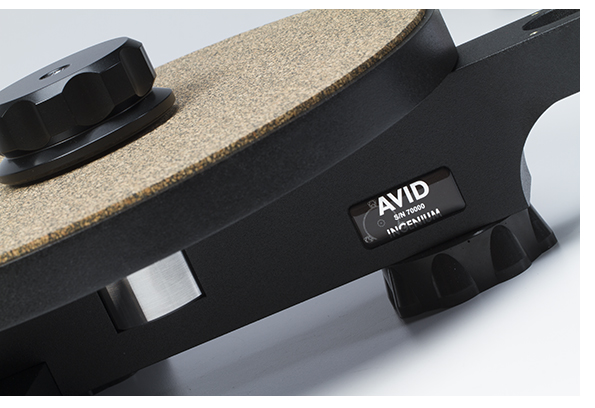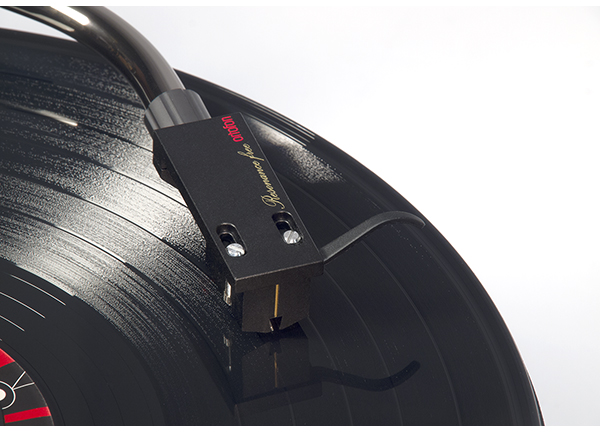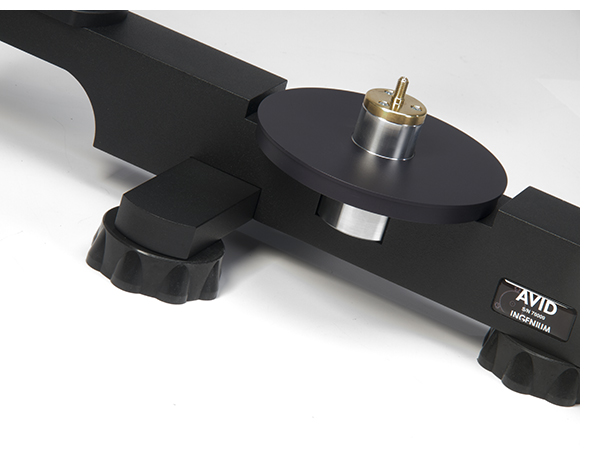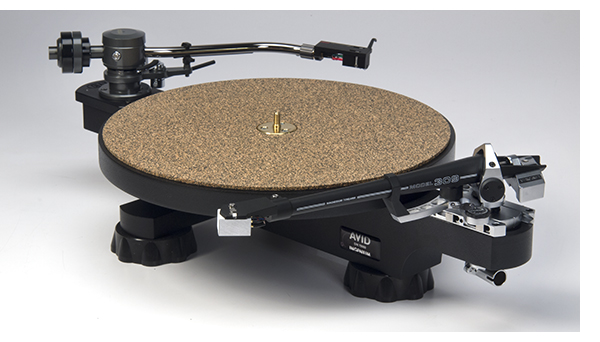In the world of racing, lighter is better and anything not contributing to getting across the finish line first is deemed useless, but in the world of turntables mass is usually considered an asset.
We’ve seen a proliferation of tables that merely just chunk on the weight – adding massive platters and enormous plinths, (often eschewing real engineering in the process) chroming everything along the way to justify a high price. This has never been the mantra at AVID.
AVID designer Conrad Mas continues to refine his design in the hope of making a table in the highly competitive price range occupied by the Rega RP6, VPI Traveler (and a few others) without compromising the engineering and performance principals that make an AVID an AVID.
 AVID has always taken a more intelligent approach, using mass where needed to get the job done along with a highly tuned suspension to extract the maximum amount of information from those delicate grooves. Their highly successful Diva and Diva IISP turntables use the same W-shaped plinth, derived from the original Acutus design, forming the critical bridge between the tonearm and the turntable bearing, with a simplified elastomer based suspension. The Ingenium’s MDF platter, bearing, spindle and clamp are directly off the Diva II assembly line; but its plinth uses a simpler, rectangle-shaped part, keeping CNC time to a minimum. It also allows the user to see the spindle rotate during playback – kind of cool for technology lovers. The elastomers are a different shape than those of the Diva series tables, but made of the same material and to the same tolerance.
AVID has always taken a more intelligent approach, using mass where needed to get the job done along with a highly tuned suspension to extract the maximum amount of information from those delicate grooves. Their highly successful Diva and Diva IISP turntables use the same W-shaped plinth, derived from the original Acutus design, forming the critical bridge between the tonearm and the turntable bearing, with a simplified elastomer based suspension. The Ingenium’s MDF platter, bearing, spindle and clamp are directly off the Diva II assembly line; but its plinth uses a simpler, rectangle-shaped part, keeping CNC time to a minimum. It also allows the user to see the spindle rotate during playback – kind of cool for technology lovers. The elastomers are a different shape than those of the Diva series tables, but made of the same material and to the same tolerance.
This configuration brings AVID performance to a wider range of customers. If AVID’s Volvere turntable is a Lotus Elise, think of the Ingenium as a Caterham 7; distilling the AVID concept as far as it can go, but no further.

Would you like some fries with that?
Setting the tonearm down on War’s “Lowrider” reveals the signature AVID sound – big dynamics and rock solid bass. You can’t have a Diva IISP for $1,350 but you do get a lot more than you bargain for at this price, and the Ingenium succeeds brilliantly. The big question is how to configure your Ingenium. The table is available without tonearm, drilled for a Pro-Ject Carbon arm for $1,300, 9-inch SME arm for $1,350 and a 12-inch SME for $1,550. It can also be purchased in a dual arm configuration for $1,950 – the model we have here. The entry level Ingenium is available with the Pro-Ject arm already installed (and it is a great arm, also featured as standard equipment on the Oracle Paris) and can be ordered with or without the AVID clamp, again an effort at keeping cost to a minimum with performance at maximum.
Mr. Mas and I have gone back and forth about the validity of a dual tonearm setup (he’s against it, I’m for it), so his catering to the true analogaholic and offering this option is highly commendable. I am convinced that this functionality, usually limited to some of the world’s most expensive turntables, is an essential feature to fully enjoy analog, whether you use that second tonearm for a mono cartridge, a budget cartridge for playing rough records, or an alternate tonal balance at the ready.
Spending a ton of cash in the context of a dual arm Ingenium isn’t necessary to reap the benefits. With so many used SME, Rega and other arms on the market, that second arm is well in reach. For this review, the SME 309 arm ($2,250 new, usually around $800 on the used market) and the new Ortofon TA-110 ($1,495 new) offer the best of both worlds – both having removable headshells, with the Ortofon using a more universal headshell, compatible with the vintage SME 3009 and the Technics SL-1200 tonearms. The Ortofon arm is easy to install, streamlining the process for those loving to mix it up with their cartridge collection. The majority of my listening was done with the Shure V15mxVr, the Ortofon MC Vivo Blue and the Zu Denon 103 – all cartridges in a range of about $400 – $600.
 I modified an Ortofon arm adaptor from the Volvere SP, but AVID should have these available shortly as a regular item for the Ingenium. Should you be as impatient as I am, the threads can be gently drilled clean with the aid of a drill press to keep the holes perpendicular to the board, allowing the threaded screws supplied with the Ingenium to clamp the board down. This is the opposite of the other AVID turntables.
I modified an Ortofon arm adaptor from the Volvere SP, but AVID should have these available shortly as a regular item for the Ingenium. Should you be as impatient as I am, the threads can be gently drilled clean with the aid of a drill press to keep the holes perpendicular to the board, allowing the threaded screws supplied with the Ingenium to clamp the board down. This is the opposite of the other AVID turntables.
A joy to listen to
Tracking through the Art of Noise’s Who’s Afraid of the Art of Noise? reveals a wide and deep soundstage, with all the minute synth bits and vocal echoes floating all over the room, well beyond the speaker boundaries – the mark of a great turntable. (or hallucinogen) The bass line in “Moments in Love” stays solid, never lacking weight or focus at the expense of blurring the musical information in the rest of the track.
The combination of layered vocals and multi-instrumental talent on Egberto Gismonti and Nana Vasconcelos’ Duas Voices, again highlights how well the AVID/SME combination retrieves inner detail and preserves transient attack. This album is full of lightning fast acoustic guitar runs and explosive percussion – Vasconcelos’ specialty. The degree of texture present with the bongos here is enlightening, and the rich decay of each guitarist’s hands as they slap against their guitar bodies adds to the dimension of realism that this table offers.
More great guitar licks abound on Ry Cooder’s Into the Purple Valley, with a plethora of layered vocals here too. This densely packed record is a torture test for low-level detail and tracking ability – if everything isn’t sorted, it just sounds like an AM radio. Another test easily passed by the Ingenium.
Basic functionality
The rock solid bass and image detail can be chalked up, in part to the excellent speed stability of the Ingenium. The Feickert analog tools reveal the Ingenium spot on in terms of speed and when monitored over time, unwavering. AVID deviates from the standard practice of most other belt drive turntable manufacturers using a low torque motor to drive the platter, choosing a high torque, high power motor instead – feeling this offers better control over the platter and minimal effect from stylus drag.
The Ingenium starts up with the sheer spin of a direct drive table, at full speed almost immediately. The only odd bit about the Ingenium is the power button; instead of being built into the plinth or in an outboard enclosure, it’s merely a rocker switch incorporated into the AC cord. Be sure to route the cable accordingly so that it can be easily accessed. A small sacrifice indeed, for this level of performance.
The basic elastomer suspension works well to isolate the table from the room. Acoustic feedback was nonexistent at high volume, and arbitrary raps near the Ingenium on the equipment rack barely came through the speakers. Not as effective as the suspended AVID tables, but way better than the non suspended tables in my collection.
 Fantastic results
Fantastic results
At the end of the test, mounting an identical SME 309 tonearm on the AVID Acutus Reference SP table confirms how well the entry level table stacks up against AVID’s finest, with the Zu Denon cartridge affixed to each arm, using the Aesthetix Rhea phonostage as a conduit to my reference system. The Ingenium provides stellar performance in the context of a Journeyman level system (Electrocompaniet integrated, a pair of KEF LS-50s and the AVID Pellar phonostage), and it is no slouch in my reference system. Compared to AVID’s top table, the lineage is clearly confirmed. The Ingenium shares all of the same virtues of the Acutus Reference SP, just in a smaller dose.
True to the AVID design brief, each table up the range consistently reveals more music than the one before it. Having owned or reviewed every AVID table in the range except the Sequel, I can say this with 100% confidence.
Because our test Ingenium is fitted with a tonearm costing nearly twice as much as the table itself, even cursory comparison with the Rega RP6 and VPI Traveler isn’t fair. However, it is to AVID’s credit that this table performs so well with the 309, offering the prudent enthusiast a major glimpse at what high end analog is really all about without spending five figures. We will get a standard edition Ingenium without clamp and featuring the Pro-Ject arm to investigate further very soon.
Utilizing the second tonearm configuration proves a ton of fun. The Ortofon arm makes it a cinch to go through my collection of cartridges mounted on the standard Ortofon headshells, swapping one for the other at will. Though slightly retro, the Ortofon SPU is another heavenly match for the Ingenium. Substituting the Lyra Kleos Mono, normally used on the Thorens TD-124 extracts a great performance from my mono Beatles and Stones records. Grado, Ortofon and Denon (to name a few great examples) all offer fantastic mono cartridges in the $200 – $300 range, so you can take full advantage of this functionality without going broke, I just happened to have the Kleos on hand.
Even those with a modest collection of mono LP’s, will be surprised at how much more lifelike they sound played back with a proper mono cartridge. The Shure M97xe also proves a great match for the AVID table/Ortofon tonearm combination and provides a budget alternative as a starter cartridge, it’s excellent for tracking through questionable yard sale finds, or favorites that are warped. In some instances, the thrift store specials sound better with a low budget cartridge.
This level of performance, convenience and style makes for an award winning product. We awarded the Ingenium one of our ten Publishers Choice awards for 2012, and feel that this table is at the top of the $2,000 turntable category in every way. But just as in racing, the competition is always in your rear view mirror. The good news for analog lovers is that we all benefit from this competition.
The AVID Ingenium Turntable
MSRP: $1,350 – $2,560 (depending on configuration)
| Tonearm | Ortofon TA-110, SME 309, SME 3009 |
| Cartridge | Ortofon Vivo MC Blue, Zu Denon 103, Shure V15mxvr, Ortofon SPU, Grado Master 1 |
| Phonostage | AVID Pellar, Decware Zen, Aesthetix Rhea |
| Amplifier | Electrocompaniet ECI 3 |
| Speakers | KEF LS50, Dynaudio Confidence C1 II |
| Cables | Cardas Clear |
| Accessories | Furutech DeMag, DeStat, GIK acoustic treatments |






